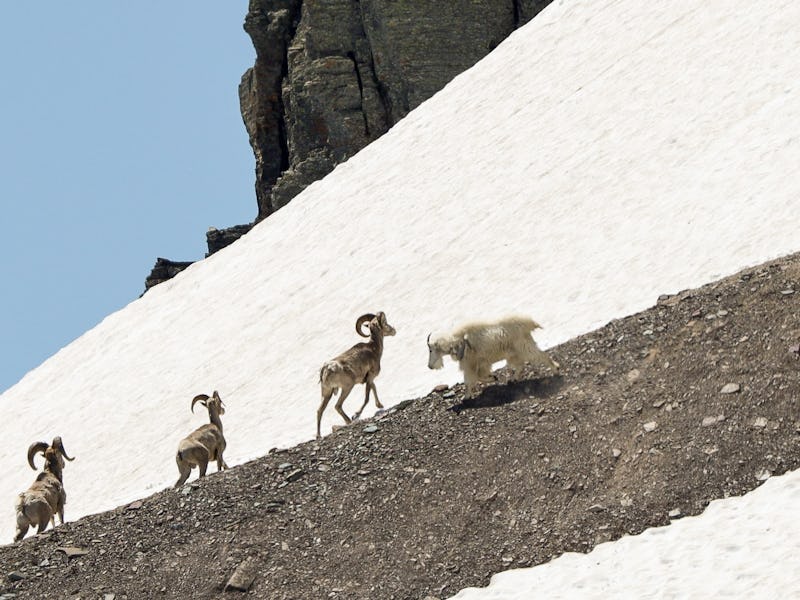This unusual behavior from sheep and goats could reveal future climate troubles
Humans can take a cue from clashing mountain goats and sheep.

In 2019, Joel Berger and Forest Hayes were scoping out grizzlies in the Rocky Mountains when they saw something peculiar. Through their spotting scopes, they saw white dots on the landscape about a mile away above the treeline: mountain goats.
Then came bighorn sheep, and things got interesting.
“All the sheep and the goats were kind of on a collision path,” Berger, a conservation biology professor at Colorado State University and senior scientist at the Wildlife Conservation Society, tells Inverse. This wasn’t a full-out stampede, however, but groups of animals walking in the same direction. They all gathered around soil patches.
The duo returned the following day and noticed even more animals around the dirt patches. “That’s when it started to hit us that something interesting was going on,” Berger says. He and Hayes observed the sheep and goats munching on dirt patches. Every so often, a sheep would walk toward a goat or vice versa, and the opposing side would walk out of the way. While it’s typical to see animals of the same species butting heads (figuratively and literally), one sees it less often between different species.
“The animals kept coming back to the same spot or sometimes charging at other animals,” Berger says. “This was a resource that was of obvious importance to them and that there would be some defense of it.”
The two deduced that they were competing for salt.
“It’s been known for a long time that animals certainly need salt and mineral products to help sustain some of their body functions,” Berger says, citing naturalist John Bartman who observed deer making a pilgrimage for salt in 1741.
The two of them, along with Glacier National Park resources manager Mark Biel, co-authored a study published Monday in the journal Frontiers in Ecology and Evolution. According to the trio, it’s not just bighorn sheep and mountain goats in this conflict, and the behavior points to something bigger.
Berger and Hayes observed mountain goats dwelling at locations higher than 14,000 feet.
What’s new — A reason for such an uncommon interspecies conflict could be that climate change is forcing them to compete for finite resources.
In this study, Berger and his team observed dozens of interspecies interactions at three sites along the Rocky Mountains from Colorado to Alberta. The team assessed four resources — shade, minerals, water, and snow — based on how these high-dwelling sheep and goats vied for them.
“There’s a climate signal for us,” he says, “and we knew that the species were competing over a very limited and patchy resource.”
While the team observed sheep and goats at over 14,000 feet for this study, this conflict doesn’t occur only at high altitudes. It’s a pattern across more extreme environments. “If you drop into deserts, and you look at the patchy distribution of waterfalls, we have conflicts occurring there,” Berger says. “Rhinos and elephants can go into conflict and usually deter other species while they’re drinking.”
Bighorns, with their saber-like headgear, tend to best mountain goats.
Why it matters — According to the paper, climate change can warm temperatures two to five times faster at high elevations and in extreme environments than in more temperate locales. This temperature change, in turn, affects glacial recession and soil erosion, which alters how species can access resources like minerals and water.
Berger draws a connection to our own species. “Even if we’re just one species, we’re culturally very different in different parts of the world,” he says. In other words, it’s possible that one day, humans may find themselves in combat with others for finite resources.
That’s already happening in some places. Berger notes a squeeze on resources like water in the American Southwest. He notes limits on water usage in Utah, Nevada, Arizona, and California. The Colorado River provides water for more than 40 million people, he says, and it’s in decline.
Toward the end of the video, a mountain goat appears to intimidate a pair of big horn sheep who are encroaching on precious resources.
Digging into the details — Berger says that conflict doesn’t mean a bloodbath or even the action from a David Attenborough-narrated documentary. This sort of clash isn’t the same as a cheetah hunting a gazelle, but about risking a deadly fight for precious resources.
Animals can signal to other species that they’re cruisin’ for a bruisin’. For example, Berger says, an elephant may swing its trunk and flare its ears to warn an opponent. These mountain goats might make a charge and gesture with their heads, which Berger and Hayes observed on the mountaintop.
“Even though these resources are important and limited, an animal getting involved in a fight to the death is probably not worth it,” Berger says. “Instead, the animals make some sort of a calculation about what the risk is, and try to avoid it.”
An elephant and rhino in Namibia confront each other.
What’s next — As much as this finding captivated Berger, it’s not in his main wheelhouse, so he won’t be the one to continue research.
“This is one of those serendipitous findings,” Berger says.
He urges that we need to learn to share the planet with its other inhabitants. Perhaps first, he notes, we have to learn to share it among our own species.
“We don’t see mountain goats and bighorns killing each other,” he points out. “We see a lot of that in humans.”